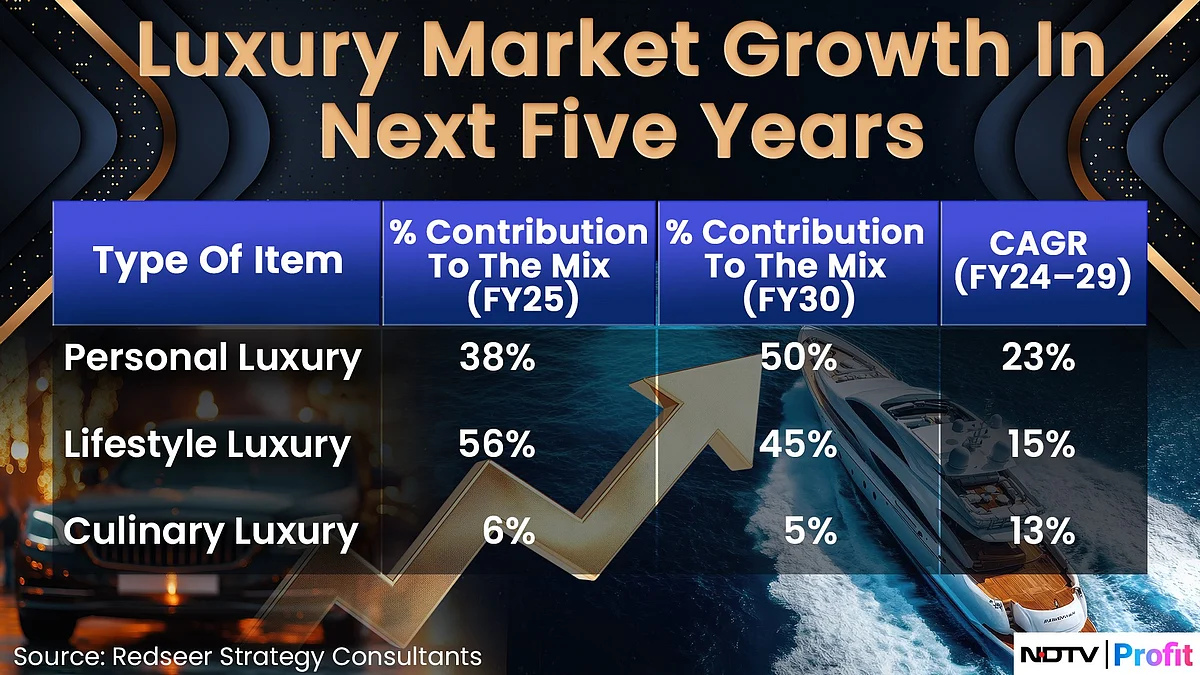Luxury Not Just For The Rich, Henrys Are Driving The Market
Personal luxury to see fastest growth as aspirational buyers bring buzz to the market.

Gone are the days when luxury was only for the rich. There is an emerging set of luxury buyers — who are not rich yet but are splurging to pamper themselves with high-end beauty products, apparel, wines and more such.
This cohort is named Henrys — high earners, not rich yet — are expected to drive the luxury market in the coming decade, as per a report by Redseer Strategy Consultants.
The report divides luxury buyers into three cohorts — the luxe connoisseurs who regularly shop for high-end goods and whose annual household income tops Rs 75 lakh per annum. They could be defined as rich.
The second cohort are "occasional splurgers" who buy luxury goods anytime between three times and right times a year; and earn anywhere in the range of Rs 25-75 lakh per annum. They are upper-middle-class buyers who combine planned luxury purchases with occasional impulse buys, influenced by special deals.
The third key set are the "aspirational elite" whose annual earnings range between Rs 10-25 lakhs but make anywhere between one-three luxury purchases a year. Even with low purchase frequency, these buyers plan and save for select luxury items while seeking the best deals.
"Amidst 'occasional splurgers' and 'aspirational elite' are Henrys, who earn anywhere Rs 20-60 lakh per annum, who are not yet HNIs but have high disposable income. Aged 25-35, they are on a path to upward mobility which pushes them towards consumption. They could be young professionals either from mid or senior level or even DINK couples," explains Ankit Yadav, engagement manager at Redseer Strategy Consultants who also worked on the report.
Most such consumers start with beauty products and go on to apparel or handbags, as they seek value, yet differentiated products, exclusive experiences and more. Luxury purchases are trickling down across income classes, and no more the domain of HNIs and UHNIs only. Consumer sector experts believe that these non-HNI customers are going to become an important set of customers — bringing in volumes to the growing luxury market in India.
"These people are in a mood to spend. Currently, they could make up for around 15-20% of the total sales, which was around 5% about 2-3 years back. I think in the next 4-5 years, they could grow to as high as 40%,” says Ninad Karpe, Karpe Diem Ventures, which invests in early-stage startups.
This set of luxury consumers do not have the burden of EMIs or do not, or even do not want to invest in real estate etc, and have more of their salaries left over to spend.
Personal Luxury Market To Zoom Ahead
India’s luxury market is valued at $27 billion as of FY25, and is expected to grow to $60-65 billion by FY30. Over half of the market currently belongs to the ‘lifestyle luxury’ segment which includes luxury automobiles, exclusive travel and hospitality, high-end furniture and home décor, fine arts excluding real estate.
Come FY30, the market is expected to be dominated by personal luxury and will make up for around half of the market, as per Redseer’s projections. Personal luxury includes apparel, footwear, eyewear, jewelry, handbags and other leather goods (excluding footwear), wearables and electronics, watches, writing instruments and stationery, and beauty & personal care items.
Personal luxury is expected to see the fastest growth – and its growing contribution to the mix indicates that luxury is becoming more democratised across income groups as they’d be dipping their toes into such purchases regularly.
“This market is sensitive to discounts, also does impulse purchases especially on special occasions like birthdays, anniversaries or even when they get a promotion or an increment,” says Yadav.
Culinary luxury which includes gourmet cuisine, fine wines and spirits – a niche segment is expected to remain so in the next five years.

Small City, Big Dreams
The attitude towards spending among the Henrys had transitioned after the pandemic. Karpe puts such buyers into three different buckets of his own. The first are the people who have earned profits in the stock markets; the next set are high profile professionals who hailed from humble backgrounds but are now in high paying jobs.
“Such professionals are in their 30s and have seen rapid increase in income; and belong to the corporate sector, especially financial services. The third are second generation entrepreneurs whose families were frugal but the new generation who has studied abroad or travelled want to spend,” explains Karpe.
As per a report named How India Spends by PwC, between 2019–24, the salary of individuals has been increasing at a rate of over 9.1% YoY. The steady growth, along with the fact that the per capita disposable income for FY24 surged to Rs 2.14 lakh, showing a robust growth rate of 13.3% YoY.
The market has been broadening in another dimension too. Many such high earners also hail from tier 2 and tier 3 cities as well. Mall culture is spreading fast with Lulu Malls in cities like Lucknow, Kochi as well as Thiruvanthapuram; Phoenix Citadel in Indore – these malls now host brands like Coach, Diesel, Montblanc, Guess, Boss and more such.
This growth in discovery of new brands – with sales driven from pop-up stores as well as brand websites is spreading way beyond top tier towns as well. Creator discovery, digital discovery, social media and more are increasing awareness which is the key growth driver.
“There is a difference in behaviour between top tier and tier 2, 3 spending on luxury too. While the former go for discreet luxury products where the logo is not as visible or brands that few have heard of, the latter go for visible luxury where the logo is well displayed. Luxe connoisseurs also go for the former, while aspirational elite and occasional splurgers go for the latter,” says Yadav.
Indian retailers have been upping their game to capture the growing love for luxury. To capture sales beyond a few flagship stores, marketplaces like Ajio Luxe, Tata Cliq Luxury and Nykaa Luxe are providing online options. Moreover, brands themselves are improving their omnichannel presence to capture a larger set of consumers.
International brands have also been advertising heavily and choosing Indian actresses as brand ambassadors. Deepika Padukone is the brand ambassador for Cartier, Alia Bhatt for Gucci, and Ananya Panday for Chanel. As more people discover luxury, faster aspirations rise — giving wings to the multi-billion-dollar market of luxury in India.
Katya Naidu is a senior business journalist who writes about equity markets, startups, energy, infrastructure, real estate and healthcare.

